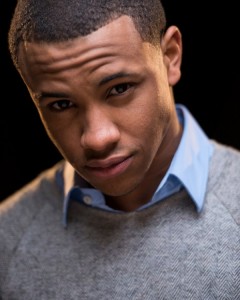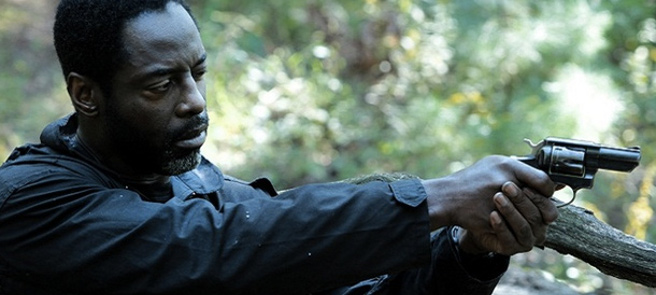
While a dramatization of the seemingly senseless Washington D.C. sniper killings of 2002 is what will attract audiences to see Blue Caprice, the film is not a stale biopic of the shooters but an exploration on their kinship of rage and abandonment, hopelessness and desperation, and yes, love.
Isaiah Washington, best known for his roles in Exit Wounds (2000), Crooklyn (1994) and television’s “Grey’s Anatomy” plays John Allen Muhammad, the mastermind behind the still light premise of the ‘beltway sniper’ shootings. We first meet John as he walks the streets of Antigua with his three ‘children’ and is stalked by wayward teenager Lee (Tequan Richmond) who after being abandoned by his mother after she found work in the United States is left scrounging for both food and guidance. After John aborts Lee’s suicide attempt in the ocean, he takes the boy in and eventually back to Tacoma, WA with him, unofficially adopted as his son. From herein is Lee’s further indoctrination into John’s plan of revenge against the world – starting with his ex-wife – and training in guns and survival techniques. Lee is at first hesitant, but feeling indebted to John he accepts his word as gospel, leading him to practice homicidal skills against people who have wronged John before they leave for D.C. and hatch their plan of chaos – traveling there cross-country in an old blue Chevy Caprice.
Some critics have used adjectives like “terrifying,” “harrowing,” and “haunted” to describe Blue Caprice. And in many ways, yes, I suppose it can be all those things, but it is also much deeper.
Their journey is so brilliantly portrayed by both Washington and Richmond that the murders feel like more like a means for an end to show the results of John’s training to make Lee ‘his’ person – akin to the training that the diminutive title character in the classic football film Rudy (1993) goes through before finally getting to play in the game. It’s a big part of what makes the killings feel even more senseless and random. This was intentional on director Alexandre Moors’ part as the focus is on the John and Lee’s relationship, not the bloodbath in which it concluded or the trail afterward.
I can see how some may also perceive John to be that devil on Lee’s shoulder compelling him to do wrong. And perhaps he was. Washington also turned out a recent brilliant performance in Russ Parr’s The Undershepherd (2012) in which he becomes ruthless in order to become the head preacher of his church. So is John the devil?
No. John is more like Anansi, the West African trickster god and most notorious of tricksters – and in this case the most appropriate, given his prowess with speech and stories, cunning and trickery, sexuality, and yes, survival. One wonders however if John is fully aware of his power, and if so, why he could not put it to better use. Being unable to move on from his failed marriage and fatherhood, coupled with enduring the rigors of racism, PTSD from the first Gulf War, and disdain for the passiveness of a society hell bent on ignoring the ‘truth,’ are more than enough to turn a man into what John became. Yet being able to employ restraint is a great deal of what makes a man truly ‘manly,’ and for a Black man in America, that is likely thrice-fold. And in protégé Lee’s case, being abandoned and left with little concept of love, makes his journey into what he believes is a man even more significant.
Blue Caprice is undoubtedly Washington’s best role and performance to date. After some time away from the business he has become the actor that many early fans, and probably even he himself, knew he could be. He carries Caprice with intensity and a confidence barely matched, making his character’s ambiguous actions even more chilling. You don’t want to root for him, but you’re forced to just accept him for who he is.

Yet the big surprise is Tequan Richmond as Lee Boyd Malvo. Richmond is best known as Drew, the younger and more attractive and confident brother to a younger fictionalized Chris Rock in the sitcom “Everybody Hates Chris.” In Caprice Richmond is the outcast, and his silent stares elevate the confusion and reluctance of his characterization. For first time feature film director Moors to unlock these performances makes him a director from whom we should expect great things.
It is also notable that screenwriter R.F.I. Porto and Moors never focus on John Allen Muhammad’s unconfirmed ties to Islamic terrorists. Those distractions take away from the unusual relationship of a father training his son to be an emotionless killer. The sound department should also receive ample credit. Beyond the startling cracks of gunfire among the wilderness during Lee’s training, as well as during the D.C. shootings, the beautiful eeriness of Antigua captured by cinematographer Brian O’Carroll (actually filmed in Puerto Rico, but nonetheless) is punctuated by the real yet starkly creepy sounds of nature they employed, as well as those in Tacoma which was also too silent and eerie.
Blue Caprice makes its theatrical premiere this Friday September 13th at the IFC Center in New York City, hits San Francisco and Los Angeles next week, then begins a wider nationwide release beginning September 27th. It will also be available on iTunes starting September 17th.
Follow the film on the Blue Caprice website and on Twitter at @BlueCapriceFilm
BLUE CAPRICE
produced and directed by Alexandre Moors
with Isaiah Washington, Tequan Richmond, Cassandra Freeman, Tim Blake Nelson and Joey Lauren Adams
screenplay by R.F.I. Porto
93 min/USA


